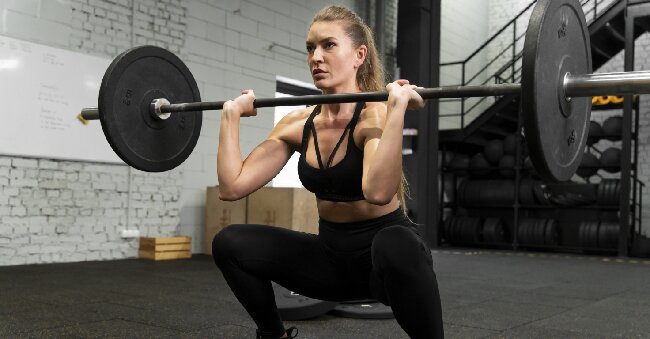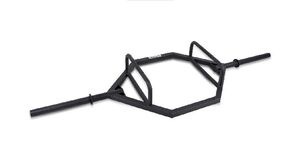
Why Invest in a Safety Squat Bar? Benefits and Workout Tips
Looking to take your squat game to the next level? A safety squat bar could be just the tool you need.
Discover the benefits of using a safety squat bar, including reducing strain on the shoulders and elbows, maintaining proper form, targeting different muscle groups, and allowing for a greater range of motion.
Learn about various exercises you can do with a safety squat bar, as well as tips for using it safely and maximizing your workout. Whether you’re a beginner or a seasoned lifter, investing in a safety squat bar could be the key to unlocking new gains in your training routine.
What Is a Safety Squat Bar?
A Safety Squat Bar is a specialized piece of equipment used in strength training. It is designed to provide a unique way to perform squats and other compound movements while reducing the strain on the shoulders and improving stability.
The design of the Safety Squat Bar includes padded shoulder rests that help distribute the weight more evenly across the upper body, reducing the risk of injury. This weight distribution not only promotes proper form during exercises but also targets the muscles in the legs, glutes, and lower back more effectively.
By incorporating the Safety Squat Bar into your workout routine, you can engage these major muscle groups while minimizing strain on your joints, making it ideal for individuals recovering from shoulder injuries or looking to add variety to their training.
What Are the Benefits of Using a Safety Squat Bar?
Using a Safety Squat Bar offers various benefits for strength training enthusiasts. It helps in targeting different muscle groups, reduces strain on the shoulders, and aids in injury prevention during workouts.
Incorporating the Safety Squat Bar into your fitness routine can enhance overall muscle activation and improve stability. The unique design of the bar promotes proper form, ensuring that the emphasis remains on the lower body muscles during squat variations. By engaging multiple muscle groups simultaneously, individuals can experience greater gains in strength and endurance. The added challenge of balancing the bar encourages proper alignment and core engagement, leading to enhanced stability and reduced risk of injury.
Reduces Strain on the Shoulders and Elbows
One significant benefit of using a Safety Squat Bar is its ability to reduce strain on the shoulders and elbows, which is particularly beneficial for individuals with shoulder stability issues or prone to joint stress.
This specialized barbell design shifts the weight distribution, allowing for a more upright torso position during squats, promoting proper spinal alignment. By minimizing the need for extreme shoulder and elbow range of motion, the Safety Squat Bar enables users to perform squats with reduced risk of injury. The unique padding on the bar helps distribute the load more evenly across the upper back and shoulders, further relieving pressure on vulnerable joints. These features make it an excellent choice for joint-friendly exercises that prioritize stability and safety.
Helps Maintain Proper Form
Another advantage of using a Safety Squat Bar is its assistance in maintaining proper form during exercises. The design of the bar promotes balance and encourages proper technique for effective workouts.
Not only does the Safety Squat Bar help in maintaining balance, but it also plays a crucial role in correcting posture and ensuring a correct squat stance. By distributing the weight more evenly across the upper back and shoulders, the bar helps athletes maintain an upright position, preventing hunching or leaning forward during squats. This aids in keeping the spine in a neutral position, thereby reducing the risk of injury and improving overall range of motion. The added stability provided by the bar enhances control over movements, allowing for smoother and more controlled repetitions.
Targets Different Muscle Groups
Using a Safety Squat Bar helps target a variety of muscle groups, including the quadriceps, hamstrings, and glutes. It promotes balanced muscle development and strengthens the lower body effectively.
The Safety Squat Bar engages the core muscles to stabilize the body throughout the exercise, enhancing overall strength and balance. By maintaining proper form and control, individuals can maximize muscle activation in the targeted areas, leading to improved performance in various functional movements. The unique design of the bar not only challenges the lower body muscles but also encourages proper alignment, reducing the risk of injury while effectively working on leg strength, hamstring activation, and glute engagement.
Allows for Greater Range of Motion
One of the key benefits of using a Safety Squat Bar is the increased range of motion it offers compared to traditional barbell exercises. This extended range enhances muscle activation and overall workout intensity.
This improved range of motion is particularly beneficial for weightlifting and compound movements, as it allows for deeper squats and lunges, engaging muscles more effectively.
By challenging stability and balance, the Safety Squat Bar promotes better form and prevents potential injuries during resistance training. This added stability not only enhances performance but also helps in developing a stronger core and lower body.
The ergonomic design of the bar redistributes the load, reducing strain on the shoulders and wrists while maintaining proper alignment throughout the movements.
What Exercises Can You Do with a Safety Squat Bar?
The Safety Squat Bar can be used to perform a variety of exercises beyond just squats. These include lunges, good mornings, and even overhead presses, making it a versatile tool for full-body workouts.
By incorporating lunges into your routine using the Safety Squat Bar, you can target your glutes, quads, and hamstrings simultaneously, enhancing lower body strength and stability.
Good mornings with the Safety Squat Bar help in reinforcing your posterior chain, engaging your lower back and hamstrings effectively.
Incorporating overhead presses with this bar enhances shoulder stability and strength, contributing to overall functional fitness and muscle building.
Squats
Squats with a Safety Squat Bar are excellent for improving lower body strength and stability. They engage various muscle groups, including the core, and are ideal for enhancing overall leg development.
The Safety Squat Bar provides additional benefits by offering excellent back support, reducing strain on the shoulder and wrist joints commonly associated with traditional barbell squats. This makes it a safer and more comfortable option for individuals with back issues, allowing them to focus on leg strength and form without compromising their spine.
Incorporating different squat variations with the Safety Squat Bar, such as front squats and box squats, can provide a well-rounded lower body workout that targets different muscles from various angles, leading to greater overall leg development and core strength.
Lunges
Performing lunges with a Safety Squat Bar can help activate the hamstrings, engage the glutes, and improve balance. Lunges are effective for targeting specific leg muscles and enhancing stability.
The unique design of the Safety Squat Bar, with its comfort padding and varied grip options, adds an extra layer of benefits to the exercise. The comfort padding reduces strain on the shoulders and upper back, allowing for a more comfortable and controlled movement. The varied grip options provide versatility in positioning, enabling users to target different muscle groups effectively. This integration of the Safety Squat Bar not only enhances the effectiveness of lunges but also promotes proper form and overall safety in the workout routine.
Good Mornings
Good Mornings with a Safety Squat Bar provide excellent back support and comfort, making them ideal for resistance training workouts. The bar’s design ensures proper alignment and reduces the risk of injury.
The padded support on the Safety Squat Bar allows for increased comfort during the exercise, which is crucial for maintaining proper posture and form. This added cushioning helps to distribute the weight evenly across the shoulders and upper back, reducing strain on the spine and lower back. By promoting better alignment and reducing the load on the lower back, practitioners can focus on targeting the intended muscle groups without compromising safety or risking injury.
Overhead Press
Using a Safety Squat Bar for overhead presses can improve shoulder stability, enhance athletic performance, and reduce joint stress. It offers a joint-friendly alternative for upper body strengthening.
The unique design of the Safety Squat Bar helps maintain proper spinal alignment during overhead presses, reducing the risk of back strain that can occur with traditional barbells. By distributing the weight more evenly across the shoulders and upper back, it also minimizes the strain on the shoulders, making it a safer option for those prone to shoulder injuries. This not only benefits experienced lifters looking to push their limits but also provides a gentler entry point for beginners aiming to build strength without risking joint pain.
How to Use a Safety Squat Bar Safely?
To utilize a Safety Squat Bar safely, it is essential to warm up properly, engage the core, and focus on maintaining good form throughout the exercises. These precautions help in injury prevention and ensure effective workouts.
Before starting your training session with the Safety Squat Bar, begin with a dynamic warm-up routine to prepare your muscles and joints for the workout. Incorporating movements like leg swings, hip circles, and bodyweight squats can enhance blood flow and flexibility.
When using the training accessory, ensure that your core muscles are actively engaged by bracing your abdominals and maintaining a neutral spine position. This stability not only enhances your balance during squats but also protects your lower back from unnecessary strain. Be mindful of the weight plate compatibility to maintain proper balance and stability as you progress in your training.
Warm Up Properly
Before starting your workout with a Safety Squat Bar, it is crucial to warm up properly to reduce the risk of injuries and prepare your body for the training routine ahead.
Engaging in a dynamic warm-up session before using the Safety Squat Bar not only minimizes the chances of strains or sprains but also enhances your overall physical performance. By gradually increasing your heart rate and blood flow to your muscles, a proper warm-up primes your body for the upcoming exercise, leading to improved flexibility, range of motion, and muscle activation. This preparation is essential for anyone pursuing an active lifestyle, as prioritizing warm-ups can significantly contribute to injury prevention and long-term physical wellbeing.
Start with Lighter Weights
When using a Safety Squat Bar, beginners should start with lighter weights to ensure proper muscle activation and gain familiarity with the equipment. This approach helps in experiencing the exercise benefits effectively.
By beginning with lighter weights, individuals allow their muscles to adapt gradually to the workout intensity, leading to a more controlled and effective fitness progression. This method also reduces the risk of injury and helps build a strong foundation for future weight increments. As one becomes comfortable with the equipment and perfects their form, they can then gradually increase the weight to challenge their muscles further, maximizing the benefits of their training routine.
Keep Your Core Engaged
Maintaining core engagement is crucial while using a Safety Squat Bar to enhance stability and balance during exercises. Engaging the core muscles helps in improving overall form and maximizing the effectiveness of the workout.
It serves as a vital tool for developing core strength, as the unique design of the Safety Squat Bar challenges the stabilizing muscles, requiring increased effort from the core to maintain proper alignment. The added weight load places a greater demand on the core muscles, aiding in their development over time.
By prioritizing core engagement, individuals can better protect their spine and reduce the risk of injury, allowing for more controlled movements and improved performance during a wide range of exercises. This versatility is what makes the Safety Squat Bar a valuable asset in building overall strength and stability.
Maintain Proper Form
Consistently maintaining proper form with the Safety Squat Bar is essential for injury prevention and muscle building. Correct alignment and technique ensure that the workout targets the intended muscle groups effectively.
Using the Safety Squat Bar not only aids in muscle activation but also helps in distributing the weight evenly, reducing strain on the lower back. By focusing on your form, you engage key muscles like quadriceps, hamstrings, and glutes, promoting balanced development and strength. Ignoring proper form can lead to imbalances, overloading certain muscles, and increasing the risk of strains or injuries. Therefore, prioritize technique and alignment when incorporating this valuable weightlifting accessory into your routine.
What Are Some Tips for Maximizing Your Safety Squat Bar Workout?
To make the most of your Safety Squat Bar workout, consider varying your reps and sets, incorporating other exercises, gradually increasing weight, and always listening to your body to achieve your fitness goals effectively.
- By varying the intensity of your workouts with the Safety Squat Bar, you can push your limits and challenge your muscles in new ways, leading to enhanced workout experiences and better results.
- Progressively increasing the weight you use on the bar will help you build strength and endurance over time.
- Adapting your routine to align with your individual fitness goals is crucial for sustained progress and preventing plateaus.
Remember, the key to optimizing your workouts is to maintain consistency and constantly strive for improvement.
Vary Your Reps and Sets
Varying your reps and sets with the Safety Squat Bar can help distribute weight effectively, promote fitness gains, and contribute to long-term health benefits. Adapting the workout routine keeps the body challenged and supports progress over time.
By incorporating different rep ranges and set schemes, individuals can target various muscle fibers more effectively, leading to enhanced muscle growth and strength development. This variability not only prevents plateaus but also reduces the risk of overuse injuries by allowing for adequate rest and recovery.
Mixing up reps and sets with the Safety Squat Bar helps improve overall fitness level by challenging different energy systems, improving endurance, and enhancing overall performance during workouts. Consistent variations in training also play a key role in injury recovery and injury prevention, ensuring a well-rounded approach to fitness improvements.
Incorporate Other Exercises
Adding other exercises to your Safety Squat Bar routine can enhance overall performance, increase caloric burn, and provide a comprehensive workout experience. Mixing exercises keeps the body engaged and supports different fitness goals.
This integration of complementary exercises not only challenges various muscle groups but also prevents stagnation in your workout routine. By incorporating diverse movements, such as lunges, deadlifts, or bent-over rows alongside your Safety Squat Bar regimen, you stimulate new muscle fibers, leading to enhanced strength gains and improved muscular endurance.
This variety in resistance training not only aids in breaking through plateaus but also ensures that your body receives a well-rounded workout, optimizing your overall fitness progress. This approach minimizes the risk of overuse injuries by distributing the workload across different muscle groups.
Investing in this equipment opens up a world of training possibilities, facilitating a holistic approach towards achieving your fitness aspirations.
Increase Weight Gradually
Gradually increasing weight with the Safety Squat Bar supports enhanced stability, promotes muscle activation, and aligns with an active lifestyle. Progressive overload is key to strength gains and overall fitness progression.
To ensure a successful workout routine, it is vital to approach weight increments methodically. By gradually adding resistance, whether through additional plates or bands, individuals can optimize their muscle engagement and endurance. This versatile tool allows for various modifications to cater to different fitness levels. It’s not just about lifting heavier weights; it’s about maintaining proper form and challenging yourself within your limits. Embracing this approach not only boosts physical strength but also contributes to injury prevention and long-term wellness goals.
Listen to Your Body
Listening to your body during Safety Squat Bar workouts is crucial for preventing injuries, ensuring fitness improvements, and maintaining joint-friendly exercise practices. Tuning into your body’s signals allows for better results and workout experiences.
By paying attention to cues such as maintaining proper alignment, you can significantly reduce the risk of strains or imbalances. It’s important to adjust the bar positioning and load according to your individual comfort and ability levels, ensuring a smooth and effective workout. Incorporating gradual increases in intensity, focusing on form over weight, and taking adequate rest between sets are essential workout tips to maximize the benefits of using a Safety Squat Bar.
Remember, the key is to work with, not against, your body to achieve sustainable progress and long-term health.




No Comments